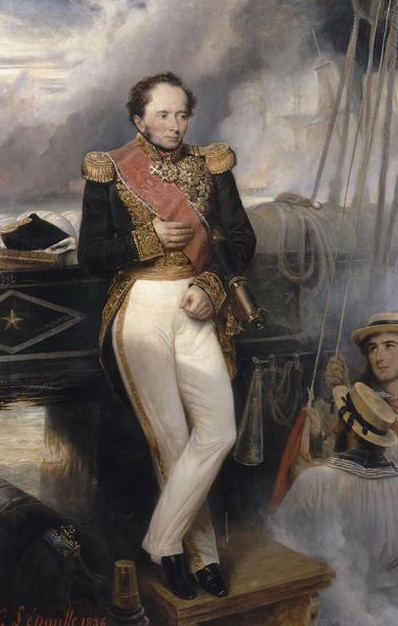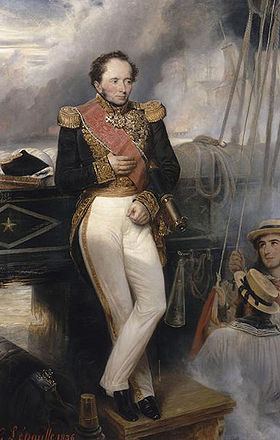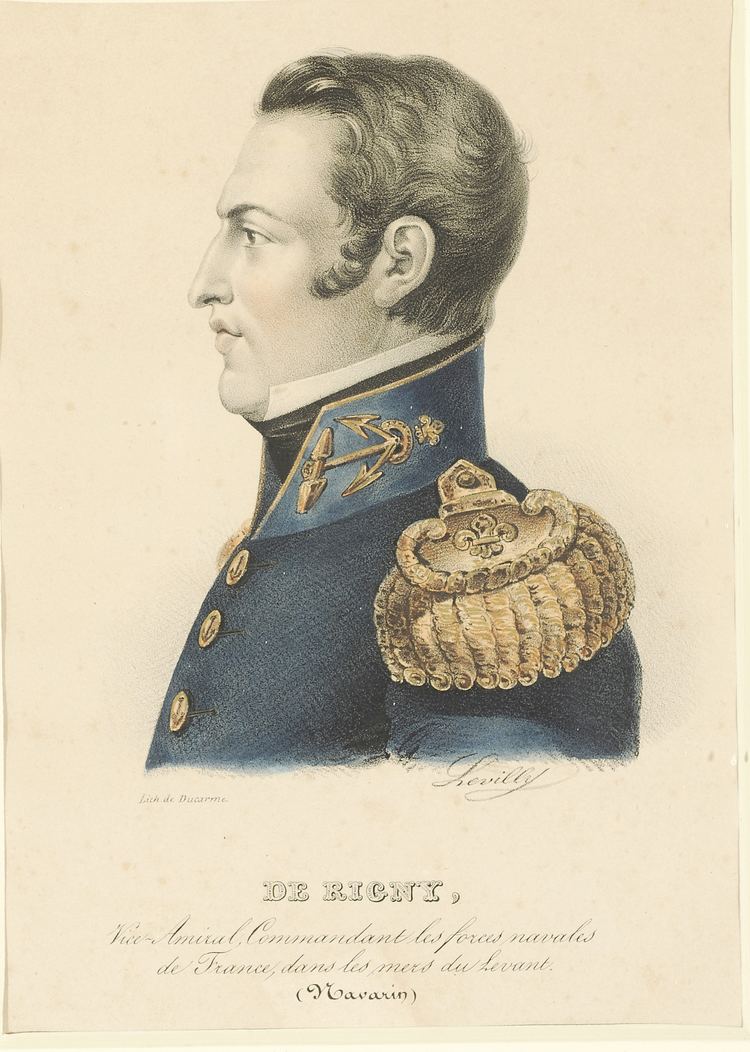Name Henri Rigny | ||
 | ||
Similar People Edward Codrington, Ibrahim Pasha of Egypt, Ambroise Louis Garneray | ||
Marie Henri Daniel Gauthier, comte de Rigny (2 February 1782 – 6 November 1835) was the commander of the French squadron at the Battle of Navarino in the Greek War of Independence.
Contents

Biography

He was a nephew of Baron Joseph Dominique, baron Louis, and son of a former captain in the Penthièvre Dragoon regiment, and who died leaving five small boys, including his brother, the future General Rigny. The French Revolution led him out of the Pont-à-Mousson school, where he had been sent. He was ten years old then, had lost his father and his mother was listed as the list of emigrants. An aunt collected the family, consisting of a young girl of sixteen years and five boys, including Henry, the eldest. After spending several months in Special School in Brest, where he had been sent there to finish his studies, in 1798, he entered the navy as a midshipman with Admiral Étienne Eustache Bruix. In 1799 he was appointed midshipman.
He assisted in the blockade of Porto Ferrajo and the Battle of Algeciras, and then he made the Egyptian campaign, and took part in the Saint-Domingue expedition, Corsica and Spain. In 1803 he was appointed ensign and as such sent to the camp of Boulogne, he was responsible for commanding the corvette La Triomphante.
Interrogated by Napoleon about the tides for the invasion of England, the young sailor gave to the Emperor a response strong and concise. Embedded with the marines of the Guard in the Army in 1806 and 1807, he made in the course of two years these campaigns Prussia, Poland and Pomerania; fought at Jena, to Pułtusk, the siege of Stralsund and Graudentz, where he was wounded. Assigned to the army of Spain in 1808, he became aide-de-camp of Marshal Bessières; he distinguished himself at the Battle of Medina de Rioseco, and was wounded at the Battle of Somosierra, and he witnessed the capture of Madrid, in 1809, and the Battle of Wagram.
Promoted to the rank of lieutenant in the same year 1809, Mr. de Rigny was in 1811 commander, and received orders to sail for the English fleet which blockaded Cherbourg and Le Havre. He accomplished this with courage dangerous mission. In 1813 he was wounded again, while clearing the village of Barselen occupied by the British.
In 1816, he was elevated to the rank of captain. In 1822 he received the command of the French naval forces assembled in the Levant (flagship the frigate Médée). He soon raised the French flag daily in these waters against the Greek and Turkish pirates, his intelligent care settled in the Archipelago Police navigation. He was appointed Admiral in 1825, and raised his pennant in his flagship Sirène. In September 1827 the French government tasked him with the enforcement of the joint resolution by France, Russia, and England, who had united to wrest Greece to the Turkish rule. He commanded the French fleet at the Battle of Navarino, which action earned him the Cross of the Order of the Bath, the Order of St. Alexander Nevsky, and promotion to Vice-Admiral.
Back in France after the evacuation of the Morea, which he chaired, the Admiral was appointed maritime prefect of Toulon in 1829. In 1829 Charles X awarded him the title of Count of Rigny, but he refused until 8 August that year, the portfolio of the Navy in the Polignac ministry. Admiral Count Rigny went into the Levant to resume command of the fleet. Returning to Toulon for health reasons, in September 1830 he was appointed to the Board of Admiralty, and received the decoration of Grand Officer of the Legion of Honor.
Called in 1831 to the Chamber of Deputies by a double election, Admiral Rigny received, on 3 March that year, Louis-Philippe, the portfolio of the navy. Assigned on 4 April 1834, the Department of Foreign Affairs, he started that administration of a new activity.
On 17 September 1834 he married Adele Defontaine Narcissus, of Mons (born 13 May 1803), widow in her first marriage to a wealthy Belgian businessman, Daniel Honnor Florent François (1780–1830), with whom she had two daughters: Elise (1826–1876), later Duchess of Padua by his marriage with Louis Arrighi de Casanova, and Leonie (1829–1892), later Marchioness of Talhouët by her marriage with Auguste de Talhouët-Roy.
On 12 March 1835 his health became increasingly unsteady, forcing him to resign his ministerial duties, but in August, he accepted a short mission to Naples. He was barely back in late October, when he felt the first attacks of which he succumbed on the night of 6 to 7 November 1835 at the age of 52 years. After his death, his widow gave birth to a daughter, Amelia Marie Gaultier Rigny, born on 7 February 1868. She married Baron Verneaux and died on 6 July 1868 at the Chateau de Ris Ris-Orangis. The Countess of Rigny, his mother also died at the Chateau de Ris on 13 November 1875.
Honours
Mount Rigny in Greenland, was named after him.
